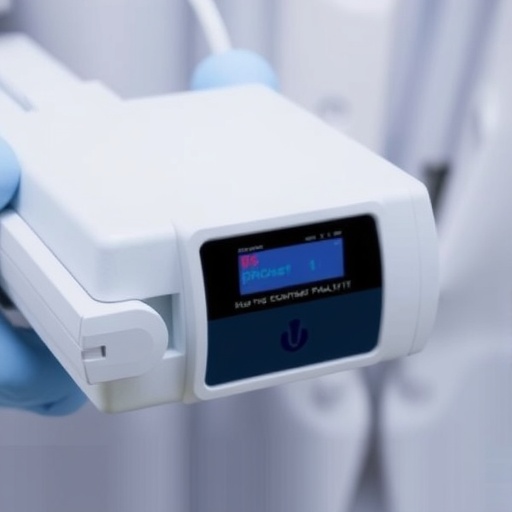In a groundbreaking analysis that promises to reshape the landscape of proteomics, a multicenter study has rigorously evaluated the performance of label-free quantification methods applied to human plasma. This ambitious endeavor addresses a critical bottleneck in biomolecular research: accurately quantifying proteins in highly complex biological samples without the need for isotope labeling or other chemical modifications. The research team, comprising international experts led by Distler, Yoo, and Kardell, presents their findings in the recently published article in Nature Communications, showcasing a high dynamic range benchmark set designed to push the limits of current mass spectrometry-based techniques.
Proteomics has long embraced mass spectrometry (MS) to unravel the complexities of protein expression, modifications, and interactions within cells and tissues. Yet, conventional approaches often rely on labeling strategies that, while effective, introduce added complexity, cost, and potential biases into quantification workflows. Label-free quantification (LFQ) methods offer a promising alternative by enabling direct measurement of proteins based on their native mass spectrometric signals. Despite their appeal, LFQ methods have historically faced skepticism due to concerns surrounding reproducibility, precision, and dynamic range capabilities, especially when dealing with samples as notoriously complex as human plasma.
Human plasma stands as an archetype of analytical difficulty, harboring proteins that vary over ten orders of magnitude in concentration. This vast dynamic range essentially demands quantification tools that are not only highly sensitive but also inherently robust against interference and technical variability that could misrepresent true biological signals. The multicenter study confronts this challenge head-on by assembling a benchmark data set encompassing proteins spanning this extensive concentration gradient, crafted with the explicit intent to test LFQ methodologies on the most demanding of biological matrices.
Executed across multiple independent laboratories worldwide, the study emphasizes the reproducibility and broad applicability of LFQ workflows. By involving different MS instrumentation platforms, sample handling procedures, and data analysis pipelines, the authors have meticulously mapped the landscape of technical variability inherent in LFQ strategies. This broad scope ensures that their conclusions are not isolated to idealized lab conditions but are highly relevant for real-world applications where diverse equipment and expertise coexist.
One of the most striking revelations is the increasing reliability of LFQ in detecting and quantifying low-abundance proteins, often elusive in plasma proteomics due to masking by highly abundant counterparts such as albumin and immunoglobulins. The study’s high dynamic range samples enabled the identification of minute quantities of biologically significant proteins that are traditionally challenging to profile without elaborate enrichment or labeling schemes. This finding signals a decisive leap forward, as it opens avenues for biomarker discovery and clinical diagnostics to harness LFQ in routine settings.
The comprehensive cross-lab comparisons illuminated subtle but impactful influences of sample preparation protocols and MS instrument settings on quantification accuracy and precision. The authors detail how optimized chromatographic gradients, data acquisition methods—including data-independent acquisition (DIA)—and bioinformatics algorithms collectively enhance the signal-to-noise ratio critical for LFQ success. This systemic approach underscores the necessity of integrating best practices across the experimental pipeline rather than focusing narrowly on individual components.
Beyond assay performance, the study delves into computational methodologies that interpret raw MS signals to derive protein abundance levels. Advanced normalization techniques and machine learning-based algorithms emerge as pivotal tools for unraveling convoluted spectral data, mitigating batch effects, and refining quantitative output. The researchers demonstrate that harmonizing experimental setups with sophisticated data analysis frameworks dramatically improves inter-laboratory concordance, pushing LFQ closer to the coveted status of robust clinical assay.
The implications of this study extend far beyond methodological refinement. By proving that LFQ techniques can reliably map the expansive protein dynamic range in plasma, the authors pave the way for cost-effective, high-throughput proteomic assays with minimal sample manipulation. This democratization of proteomics could revolutionize clinical diagnostics, facilitating early disease detection, therapeutic monitoring, and personalized medicine on unprecedented scales.
Moreover, the study’s standardized benchmark sets and openly shared datasets establish invaluable resources for the scientific community. These innovations encourage ongoing benchmarking and methodological development, fostering innovation and transparency. Such collaborative frameworks are instrumental in accelerating the pace at which proteomic technologies transition from avant-garde research tools to routine clinical and pharmaceutical utilities.
As the global scientific community urgently seeks noninvasive biomarkers and comprehensive molecular phenotyping methods, this multicenter evaluation demonstrates that LFQ proteomics stands ready to fulfill these needs. By harnessing the highest fidelity mass spectrometry methods aligned with rigorous computational corrections, LFQ platforms can deliver quantification precision once thought exclusive to isotope-labeled assays, but without their inherent drawbacks.
In sum, the work led by Distler and colleagues represents a pivotal milestone in proteomic technology development. It not only validates the technical robustness of LFQ across global laboratories but also formulates a research paradigm that bridges instrumental innovation, method standardization, and open data sharing. This holistic approach promises to dramatically enhance our ability to probe the human plasma proteome with accuracy, depth, and efficiency—a seminal advance likely to spur myriad discoveries in biology and medicine.
Looking forward, further research may capitalize on these findings by integrating LFQ with complementary omics data or advancing real-time analytical pipelines. Such integrations will likely catalyze the development of comprehensive biomarker panels and dynamic molecular profiling tools that align with the complexity and heterogeneity of human health and disease. As these platforms mature, they will become indispensable assets not only for academic labs but also for clinical diagnostics and pharmaceutical development worldwide.
In essence, this groundbreaking study charts a clear course for the future of proteomics, illuminating the path toward accessible, reproducible, and high-resolution characterization of the human plasma proteome. It signifies a transformative shift that could unlock new layers of biological understanding and clinical insights through scalable and label-free approaches, heralding a new era in precision medicine.
Subject of Research:
Multicenter evaluation of label-free quantification techniques for protein measurement in human plasma using a high dynamic range benchmark set.
Article Title:
Multicenter evaluation of label-free quantification in human plasma on a high dynamic range benchmark set.
Article References:
Distler, U., Yoo, H.B., Kardell, O. et al. Multicenter evaluation of label-free quantification in human plasma on a high dynamic range benchmark set. Nat Commun 16, 8774 (2025). https://doi.org/10.1038/s41467-025-64501-z
Image Credits:
AI Generated
Tags: accuracy in protein measurementadvancements in mass spectrometry techniquescomplexity of biological samplesdynamic range in proteomicshuman plasma analysisisotope labeling alternativeslabel-free quantification methodsmass spectrometry in biomolecular researchmulticenter proteomics studyNature Communications publicationprotein quantification challengesreproducibility in label-free quantification





